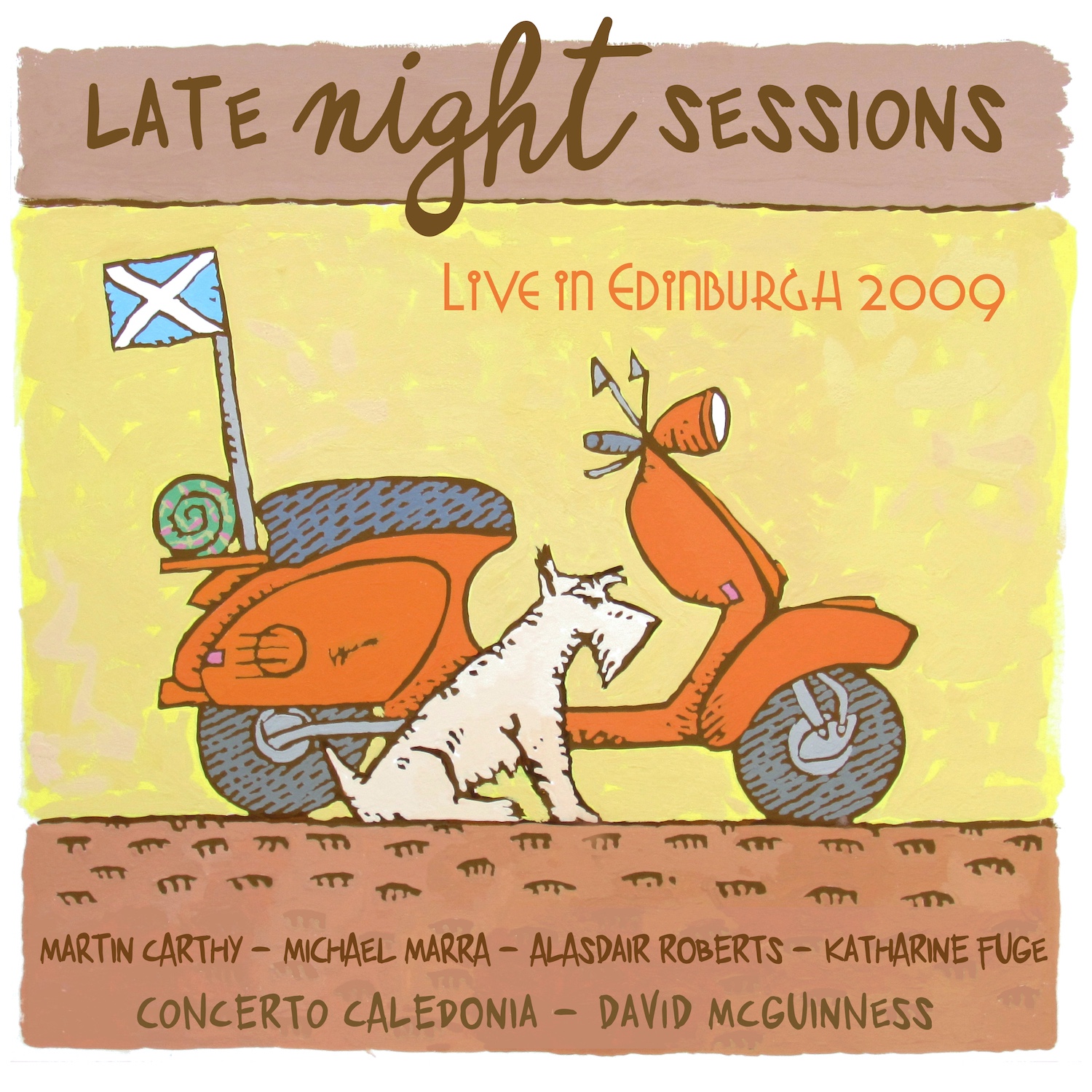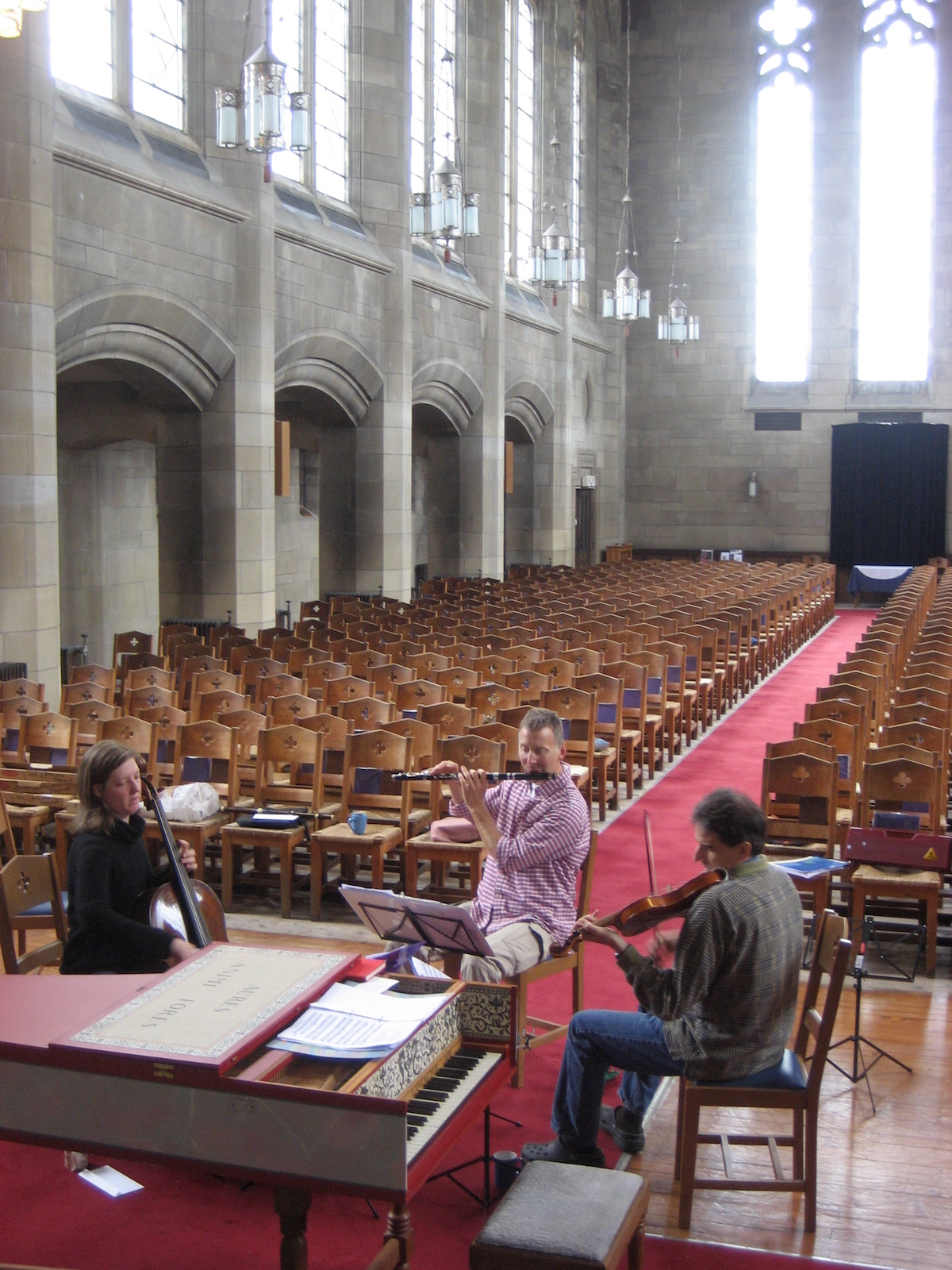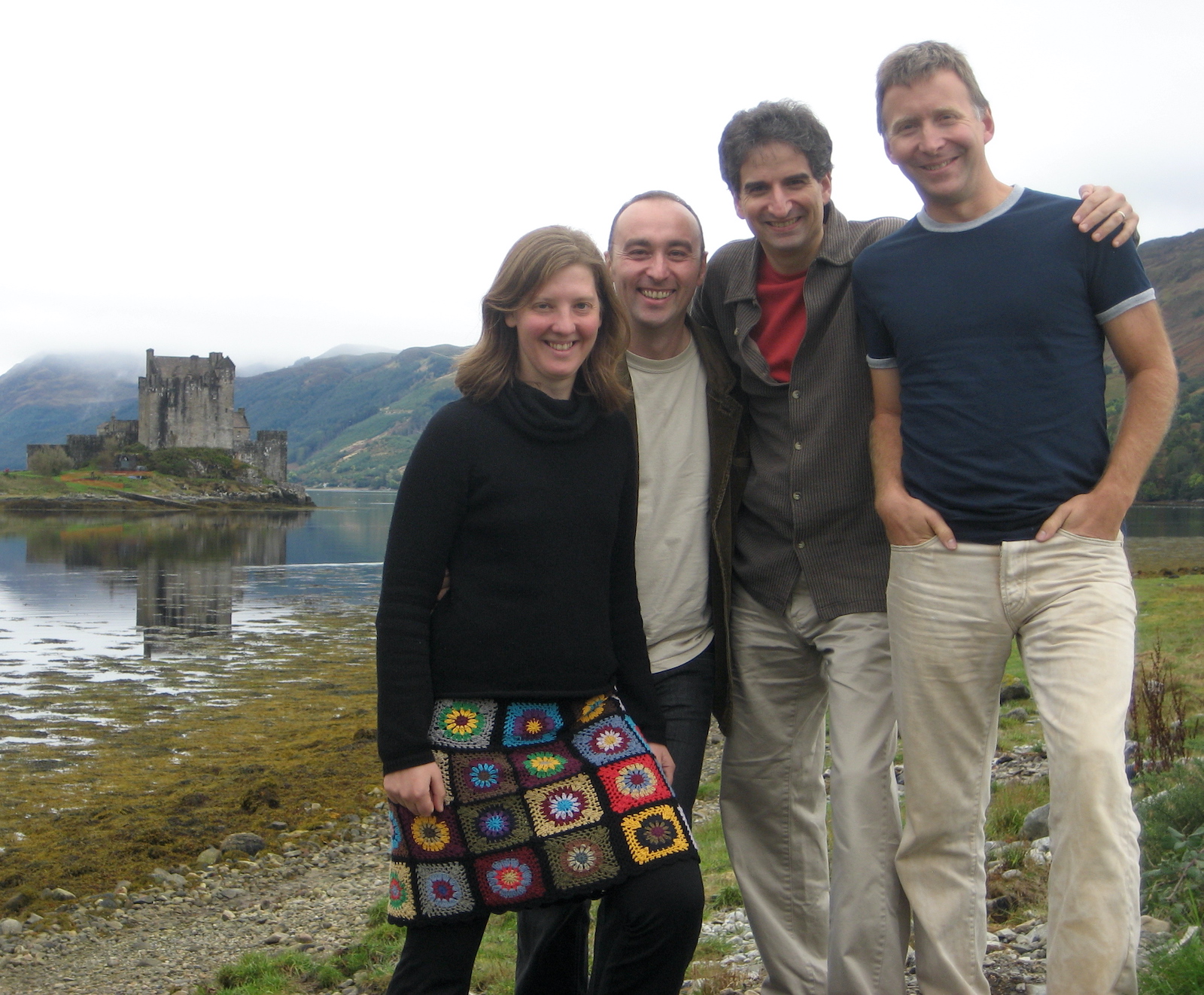
Late Night Sessions
Live at the Edinburgh International Festival 2009
with guests
Martin Carthy, Michael Marra,
Alasdair Roberts & Katharine Fuge
Four genre-busting nights at The Hub distilled into an exhilarating 62 minutes.
Concerto Caledonia
David McGuinness – harpsichord, fortepiano (2, 12), reed organ (2), melodica (13)
David Greenberg – violin, octave violin (11)
Chris Norman – flutes, whistle (13)
Alison McGillivray – cello, viol (1, 3, 4, 6)
with
Bill Taylor – wire-strung clàrsach, bray harp (3, 6)
Elizabeth Kenny – theorbo, lute (7)
Steve Player – guitar
Patsy Seddon – clàrsach
Sarah Bevan-Baker – violin
Nicolette Moonen – viola
and guests
Alasdair Roberts – voice, guitar
Michael Marra – singer
Martin Carthy – voice, guitar
Katharine Fuge – soprano
Recorded in The Hub, Castlehill, Edinburgh on 20, 22, 24 & 26 August 2009
Producer: David McGuinness
Engineer: Steve Portnoi
Mastering: Paul Baxter
Cover painting: Joe Davie
Design: Ewan MacPherson, Quiet Design
Thanks to Jonathan Mills and Matthew Studdert-Kennedy at the EIF; Noel O’Regan for lending us his harpsichord when the expected one didn’t turn up; Malcolm Greenhalgh and Meg Munck for keyboard tuning; Alison Goring, our Performance Manager at the Hub; Andrew Logan; John Purser; Mark Summers; our Board; all our friends, supporters and families; and to Barnaby Brown, Alan Emslie and James Gilchrist, who appeared in the concerts but through no fault of their own didn’t make it on to the recording.
1
The Book of Doves with Alasdair Roberts
(Alasdair Roberts)
BT PS CN MC AMcG DMcG
This song of the history of faiths comes from Alasdair’s album Spoils and, never one to take responsibility lightly, he brought along site-specific lyrics specially for this performance. The very week in August 2009 that we were playing, the Perseid meteors were active in the skies.
2
Marshall-Burns with Michael Marra
(William Marshall/Robert Burns, arr. Greenberg/McGuinness/Marra)
DG DMcG
Miss Admiral Gordon’s Strathspey (Of A’ the Airts)
My Love Is Lost To Me (O Were I On Parnassus Hill)
The Highlander’s Farewell (Highland Harry)
The Bog of Gight
Miss Gunning’s Reel
This is a potent broth of tunes from Robert Burns and the fiddler William Marshall, who was described by Burns as ‘the first composer of Strathspeys of the age’. Marshall’s entire working life was spent in the service of the Duke of Gordon, eventually managing the family’s Fochabers estate as factor. The Gordons clearly valued him highly enough to allow him to develop his talents in many directions: besides music, he acquired skills in clockmaking, astronomy, architecture and even athletics. The touching love song ‘Of A’ the Airts’ was written to ‘Miss Admiral Gordon’s Strathspey’ by Burns on his honeymoon; we follow it with two other tunes that were made into songs by Burns, and round off the set with two more tunes from Marshall.
‘Miss Admiral Gordon’ and ‘The Bog of Gight’ are from Marshall’s Volume 2nd of a Collection of Scottish Melodies (1845), ‘My Love Is Lost To Me’ appears in James Oswald’s Caledonian Pocket Companion Book 5 (c. 1754), ‘The Highlander’s Farewell’ is in Neil Stewart’s A Collection of the Newest and Best Reels of 1761-63, and ‘Miss Gunning’s Reel’ appeared along with Marshall’s ‘Kinrara’ on a single sheet around 1800.
In this set, I particularly enjoyed testing the dynamic range of Christopher Hogwood’s fortepiano, and for the most part I followed the bass lines in Marshall’s books, which were written for Marshall by the Catholic priest at Dufftown, Mr George Gordon. You can still find copies of Gordon’s eclectic two-volume Sacred Music Calculated for the Use of Small Choirs (c. 1830) in many a church organ loft in the north-east of Scotland.
3
Sir Patrick Spens with Martin Carthy
(trad. arr. Carthy)
DMcG AMcG CN BT PS
Whether there really was a master mariner Sir Patrick Spens we don’t know, but the ballad that bears his name tells the tale of a historical event, the doomed journey to bring home the Scottish Queen Margaret, Maid of Norway in 1290. The words sung by Martin are from various different versions of the song, and he found the tune in Albyn’s Anthology vol. 2, collected by Alexander Campbell (1818), and in William Christie’s Traditional Ballad Airs vol. 1 (1876).
4
The Duke of Athol’s March
(trad. arr. Norman)
CN AMcG BT PS
The big music or ceòl mòr for the big pipes or Highland bagpipe appears here on a considerably quieter pipe, as Chris plays a pibroch on the flute. The source for the tune, Daniel Dow’s 37 New Reells & Strathspeys of c. 1775, certainly doesn’t rule this practice out – in an effort to increase its sales as widely as possible, the title page proclaims its contents as being suitable for ‘the Violin, Harpsichord, Piano Forte, or German Flute’.
5
The Roses in Jamaica
(C. McNab)
CN DG AMcG
Mr Samuel Rose’s Reel of Jamaica
Miss Rose’s Fancy of Jamaica
Scotland’s use of slavery in the West Indies to build its wealth in the 18th and 19th centuries is something that as a nation we’ve usually preferred to keep quiet about, but the plentiful Scottish surnames now found in Jamaica bear eloquent witness to this less than proud part of the nation’s past. Even Robert Burns was only saved from a career in the slave trade by the success of the first Kilmarnock edition of his poems. Published in Campbell’s 8th Collection of Country Dances in London in 1794, these two tunes by ‘Mr. C. McNab’ are dedicated to some of around 17,000 Scots who did make the journey to the Caribbean.
6
Paven
(Duncan Burnett)
DMcG EK AMcG BT
This keyboard pavan of great dignity was probably composed by the Glasgow musician and teacher Duncan Burnett: he wrote it down in his music book around 1610 and signed it with his own initials, alongside pieces by Byrd and by his fellow Scot William Kinloch. We play it here on a ‘meta-harpsichord’: one with a few extra instruments added on!
7
Chiling o guiry
(arr. Burk Thumoth)
DG SP EK BT DMcG
This setting, from Burk Thumoth’s Dublin book 12 Scotch, and 12 Irish Airs With Variations (c. 1745), appears pretty much note for note in a Scottish source as ‘Sholla Negari wt the Variation’, and there are plenty of other variants of both title and tune: it may have eventually morphed into the well-known jig ‘The Drunken Parson’. Síle Ní Ghadhra was one of several allegorical names for Ireland, so the tune would have carried a certain patriotic symbolism for Irish exiles.
Rather than take the sensible course of action and have David G accompanied by one or two instruments at the most, we gave him four accompanists, and he then led us a merry dance in the concert, so that we never quite knew what he was going to do next. I think we’d planned to pick the tempo up again after the slow section, but on the spur of the moment it seemed like much more fun not to.
8
Alloway House
(arr. James Oswald)
9
The Secret Kiss with Katharine Fuge
(James Oswald)
AMcG DMcG CN
The tune ‘Alloway House’ is drawn from book 1 of James Oswald’s Caledonian Pocket Companion (c. 1745), the collection of pocket tune books which eventually ran to 12 volumes and was the making of Oswald’s fortune in London. The only instrument mentioned by name on the cover of the first two books is the flute, but Oswald himself played the tunes on the bass fiddle, or cello. His later tendency towards decadent arrangements in the 1760s brought a gentle censure from Benjamin Franklin, who preferred to hear the tunes without a confusing artificially-composed bass line.
Whoever has heard James Oswald play them on his Violoncello, will be less inclin’d to dispute this with me. I have more than once seen Tears of Pleasure in the Eyes of his Auditors; and yet I think even his Playing those Tunes would please more, if he gave them less modern Ornament.
With words by Robert Dodsley, ‘The Secret Kiss’ is the second song in Oswald’s 12-part song cycle Colin’s Kisses, which he published in 1742 not long after his arrival in London. John Purser has suggested that the secret wooing in this song may have reflected Oswald’s own courtship with Marion Melvill, of which her family did not approve.
10
The Scots Chaconne
(John McLachlan, arr. McGuinness)
DG CN AMcG DMcG EK SP BT
This wild tune appears in what’s become known as ‘the Bowie manuscript’, now in the National Library of Scotland. Bound in with it is a note from George Bowie in 1705, promising to pay back a loan of £12 Scots to one MM: Aaron McGregor has noted that MM is probably the fiddler John McLachlan’s widow, Margaret McKenzie.
McLachlan is the first Scots fiddler about whom we know very much. He was working in Edinburgh in the 1690s, and a great many tunes in the Balcarres Lute Book are given descriptions such as ‘Galloway thom, mr McLaughlans way, by mister Beck’: arrangements for the lute by John Beck of McLachlan’s fiddle-playing. The tune ‘Mr Mc Clauklaines Scotch-measure’ was published by Playford in 1700, remained popular in many sources throughout the eighteenth century, and is still played today.
Despite its title, the ‘Scots Chaconne’ may not sound obviously Scottish to us – and to be honest, it’s not really a chaconne either. The title given to it in the Leyden MS at Newcastle University, which was probably made by the same compiler as the Bowie MS, is ‘The Scots Shechone’.
11
Reading ends in Melancholy with Katharine Fuge
(John Abell, arr. McGuinness)
CN SBB DG AMcG DMcG
John Abell was that rarity among men, an Aberdonian celebrity countertenor. After a scandalous marriage into the aristocracy, and several years spent travelling in Europe, where his Catholic sympathies were more welcome than at home, he returned to London in 1699 to sing in the Theatre Royal at Drury Lane. This hymn to friendship is from his Songs in Several Languages of 1701, one of two songbooks he published that year, possibly in an attempt to clear some of his accumulated debts.
More than one account survives of Abell’s temperamental nature. On his return to London, the playwright William Congreve wrote:
Abell is here: has a cold at present, and is always whimsicall, so that when he will sing or not upon the stage are things very disputable, but he certainly sings beyond all creatures upon earth ...
12
Allegro from Quartetto op. 6 no. 1 in E flat
(J. G. Christoph Schetky, ed. Summers/McGuinness)
DG SBB NM AMcG DMcG
J.G. Christoph (or Christoff) Schetky was a great friend of Robert Burns: in fact, if he hadn’t had such an obviously foreign name he would surely have made it into one of Burns’s most famous drinking songs, as Christoff often drank with that song’s protagonist Willie (Nicol) and his friends Rob (Burns) and Allan (Masterton).
O Willie brew’d a peck o’ maut,
And Rob and Allen cam to see;
Nicol and Masterton were both masters at Edinburgh High School, and Schetky’s sons were once saved from a beating by Burns when, after they had escaped a school day by hiring a boat from Leith, they tried in vain to sneak past Nicol’s house on their way home. Burns intervened in the ensuing row with their father and their teachers, handed them a couple of bawbees to get some supper, and told them to ‘rin home like gude bairnies, an’ get to your schule the morn’.
Although Schetky was German-Hungarian and born in Darmstadt, his grandmother was a McPherson from the Western Isles who sang him Gaelic lullabies as a child, and so by the Concerto Caledonia rule of ‘Could he play football for Scotland?’, we claim him as a Scottish composer by descent as well as by adoption. Schetky was enticed to his ancestral homeland in his thirties, when the Edinburgh Musical Society engaged him as their principal cellist; he seems to have enjoyed his adopted country very much, and was certainly held in very high esteem by his fellow musicians. He was brought out of retirement for his final public performance aged 78, to play at the very first Edinburgh Festival in 1815.
In this opening movement from his Six Quartettos of 1777, he generously writes some high solo passages for himself to play on the cello. If you’re wondering why there’s a piano playing in a string quartet, Schetky provided the cello part with figures for that very purpose: somehow I don’t think it would work quite so well on a modern Steinway.
13
Black Jock including Black, White, Yellow and Green with Katharine Fuge
(trad. arr. Greenberg/trad. arr. Shirley & Dolly Collins)
DG CN DMcG
No one seems quite sure what the various-coloured ‘Jocks’ (or ‘Jokes’) to be found in tune titles represent. Besides ‘Black Jock’, there are similar tunes entitled ‘Blue Jock’, ‘White Jock’, even ‘Yellow Jock’. ‘Black Jock’ is dressed up here in two guises, as an English song and a Scots set of variations. I hope we haven’t taken too many liberties with Shirley and Dolly Collins’s arrangement of the song; David G has taken his variations mostly from Robert Bremner’s A Curious Collection of Scots Tunes (c. 1759). Listen to how even the distant gun from the tattoo at Edinburgh Castle is drawn into his rhythm. The fiddle scordatura is G–D–G–D.
notes on the music © 2010 David McGuinness
In 2009 Jonathan Mills, director of the Edinburgh International Festival, offered us four nights at the festival’s own venue next to the Castle, to do pretty much what we wanted. This is not the kind of invitation you can pass up, so we rounded up some musical friends, and in a series of late-night concerts presented a collection of music from Scotland through the centuries. It was a great opportunity to draw on our repertoire of the previous 17 years, and to invite a few special guests to add some new discoveries along the way.
This album presents a selection of favourite moments from those four nights at the Hub, showing just some of the fun that we had onstage. If you listen very carefully, you can also hear the creaky rostrum, the gun going off in the Tattoo at the Castle next door, and sometimes the battle between our tuning and the air conditioning system. On some so-called live albums, the music is assembled from patching sessions that take place after the audience has gone or even before they arrive, but everything you hear on this recording happened on stage in the shows. It’s guaranteed live, and all the better for it!






The word ‘fun’ came to my mind before I read the introduction. It’s not a knees-up, but one feels that the 13 tracks show the musicians in relaxed enjoyment – perhaps like a series of encores. But the music is emotionally and technically extremely varied, showing Scottish folk-based music at its most approachable. The programme is made up from live (undoctored) recordings from a series of late-night concerts at the Edinburgh Festival last year. The basic quartet (David McGuinness, David Greenberg, Chris Norman and Alison McGillivray) is supplemented by six more players (Bill Taylor, Liz Kenny, Steve Player, Patsy Seddon, Sarah Bevan-Baker and Nicolette Moonen) and four singers (Alasdair Roberts, Michael Marra, Martin Carthy and Katharine Fuge) – a fair number of familiar names there! A lot of the music is folk (one might class the first track as that) but it isn’t a programme that requires classification. There are informative notes on each piece: there’s a nice commendation of Oswald by Benjamin Franklin!
Clifford Bartlett, Early Music Review, August 2010
